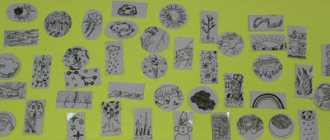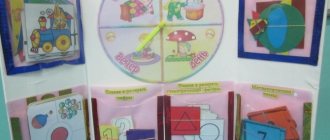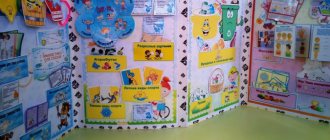Relationships between preschoolers in a play situation
RELATIONSHIPS OF PRESCHOOL CHILDREN IN A GAME SITUATION
There are two types of relationships in the game - gaming and real. Game relationships reflect relationships in plot and role. So, if a child has taken on the role of Karabas Barabas, then, in accordance with the plot, he will be exaggeratedly angry towards children who have taken on the roles of other characters in A. Tolstoy’s fairy tale “The Adventures of Pinocchio, or the Golden Key”.
The real relationship is the relationship between children as partners, comrades doing a common task. They can agree on the plot, the distribution of roles, and discuss questions and misunderstandings that arose during the game. In play activities, certain forms of communication between children arise. The game requires from the child such qualities as initiative, sociability, and the ability to coordinate his actions with the actions of a group of peers in order to establish and maintain communication.
Elements of communication appear very early, when children do not yet know how to build a detailed story game, but play individually - each on their own. Typically, during this period of play development, the child is focused on his own actions and pays little attention to the actions of another child. However, from time to time, fed up with his own play, the baby begins to look at how another child is playing.
Interest in a peer’s game leads to attempts to establish certain relationships. The first forms of relationships are manifested in the child’s desire to get closer to another child, to play next to him, in the desire to give up part of the space occupied for his own play, in a timid smile given to another at the moment when the children meet their gaze. The interaction of a child with a peer is short-term. The content of the game does not yet provide grounds for sustainable communication. At this stage, children can exchange toys and help each other.
With the development of gaming skills and the complication of game plans, children begin to engage in longer-term communication. The game itself demands this and promotes this. Penetrating deeper into the life of adults, the child discovers that this life constantly takes place in communication, in interaction with other people. The desire to reproduce adult relationships in play leads to the fact that the child begins to need help .
partners who would play with him. Hence the need arises to come to an agreement with other children and organize a game together that includes several roles.
In playing together, children learn the language of communication. Mutual understanding and mutual assistance, they learn to coordinate their actions with the actions of others. Bringing children together to play together helps to further enrich and complicate the content of games. Each child's experience is limited. He is familiar with a relatively narrow range of actions performed by adults. In the game there is an exchange of experience. Children adopt each other’s existing knowledge and seek
help to adults.
Game relationships can be complicated by real ones if the initiator of the game takes on the role of a subordinate, but actually continues to lead the game. With the development of the ability to create a detailed plot plan and plan joint activities, the child comes to the need to find a place among the players, establish connections with them, understand the desires of the players and balance their own desires and capabilities with them. If the children fail to agree among themselves, the game will fall apart. Interest in the game and the desire to participate in it lead to the fact that children make mutual concessions.
In play activities, the mental qualities and personal characteristics of the child are most intensively formed. The game develops other types of activities, which then acquire independent meaning. Gaming activity influences the formation of arbitrariness of mental processes. Thus, in play, children begin to develop voluntary attention and voluntary memory. During play, children concentrate better and remember more than in laboratory experiments. The conscious goal (to focus attention, remember and recall) is highlighted for the child earlier and is easiest in the game. The very conditions of the game require the child to concentrate on the objects included in the game situation, on the content of the actions being played out and the plot. If a child does not want to be attentive to what the upcoming game situation requires of him, if he does not remember the conditions of the game, then he is simply driven out by his peers. The need for communication and emotional encouragement forces the child to focus and remember.
At the same time, the child’s experience of gaming and especially real relationships in role-playing games forms the basis of a special property of thinking that allows one to take the point of view of other people, anticipate their future behavior and, depending on this, build one’s own behavior.
Literature
Raising children in the senior group of kindergarten / V.V. Gerbova, R.A. Ivankova, R.G. Kazakova and others - M: 1984
V.S. Mukhina, “Child Psychology” - M.: 2000
M.A. Panfilov “Game therapy of communication” - M.: 2002.
MAGAZINE Preschooler.RF
MDOU combined type kindergarten No. 7 “Forest Fairy Tale” Prepared by: teacher of speech therapy group No. 6 Semenova I.V.
In role-playing games, favorable conditions are created for the formation of relationships between children. Research conducted by A.P. Usova and her students revealed the following levels (stages) of the formation of such relationships throughout preschool childhood:
- The level of disorganized behavior that leads to the destruction of other children's games (the child takes away toys, breaks buildings, interferes with children playing).
- Singles level. It is characterized by the fact that the child does not interact with other children, but does not interfere with their play.
- The level of games nearby is manifested in the fact that two or three children can play at the same table, on the carpet, in a doll's corner, but each acts in accordance with his own play goal, realizing his own plan. The value of this level lies in the fact that the child develops an understanding of how to relate to another’s play: one must not interfere, one must not take into account the other (make room, exchange a toy, or give up one’s own). At this level, conditions are created for the natural unification of players.
- The level of short-term communication and interaction is characterized by the fact that the child for some time subordinates his actions to the general plan. The new stage of the game is characterized by the emergence of a plan and the desire of children to select appropriate toys and objects. But the idea is not yet stable; during the game, children can change it or forget about it. Someone may leave the game, which will lead to its collapse and conflicts.
- The level of long-term communication is interaction based on interest in the content of the game and the actions it requires.
- The level of constant interaction based on common interests and selective sympathies. Children united by friendly interests are able to yield to each other in choosing a plot, distributing roles, and coordinating their actions.
In order to correctly judge the nature of the relationships that develop between children in a kindergarten group, the teacher should constantly observe the children’s interactions in play and other types of educational activities.
In cultivating in children attitudes of goodwill towards each other, it is important during games to attract their attention to the interests and needs of peers nearby. It is necessary to cultivate in children a desire to help a peer, to share with him, to respond to his request.
It is necessary that children take into account the right of each child to participate in joint play, be able to ask their peers in a friendly and friendly manner to play together (“Please accept me,” “Can I play with you?”), and respond to the request in a friendly manner
Comrade, take him into the game. It is necessary to teach children to be attentive to the suggestions of another child when performing joint activities, to be able to agree with the plan proposed by a peer.
If children do not know how to kindly and politely refuse to participate in a common activity or reject the proposals of another child, you should discuss with them the form of refusal, teach them to express disagreement tactfully (“Let’s build a road first, and then a bridge. Agreed?”), and politely answer to refusal (“Do you want to play store? Maybe we can play hospital?”).
The teacher draws children's attention to the inadmissibility of rude, harsh addresses and responses that express disdain for the interests and desires of a peer.
In addition to talking with children, you must show them specific situations. For this you can use puppet theater, shadow theater and toy theater. The characters in the plays help children learn the rules of politeness necessary when communicating.
Semenova I.V.
§ 2. Relationships between children in play
The relationship between the children entering the game is not easy. The duality of play interaction between preschoolers, arising both from the combination of the role taken on and from the characteristics of the child’s personality, is especially clearly manifested in the nature of the relationships that arise between children at play.
First of all, plot role-playing game occurs in a group of children who already know each other. In this group, before the start of the game, a certain system of personal relationships had already developed, in which, as already indicated, each child occupies one place or another and has one or another sociometric status. These relationships manifest themselves in the very first stages of the game: a gaming group arises on the basis of selective sympathy. It, as A.P. Usova points out, can be united first by interest in the content of the game, and then by the children’s interest in each other. Another motive for unification is also possible: children who mutually sympathize with each other unite to play according to a plot that somehow suits the majority. There may be cases when a child seems to sacrifice his gaming interests for the sake of the opportunity to communicate with certain impressive or influential group mates. Such “play groups,” notes A.P. Usova, “arising on the basis of personal interest, may be the most interesting phenomenon in a child’s life.”
Real intra-group relationships largely determine the next stage of the game—the distribution of roles. As research shows, the most interesting roles are most often captured by children with high status (sociometric “stars”), who receive the largest number of choices in the corresponding experiments. In this case, they also become the leaders of the gaming group, directing the plot of the game at their own discretion, determining its specific content, distributing other roles, and assessing the reliability and “correctness” of their performance.
To achieve such a leadership position, it is not enough to have a high sociometric status; organizational skills are also required, as well as the corresponding reliability and “correctness” of their execution, so that a group member who is liked by many peers still does not become a leader, an organizer of the game. Research has shown that there is a close interdependence between the child’s position in the group and his qualities as a participant in the game: often it is these qualities, manifested in the game, that determine the preschooler’s status among his peers.
Development of communication of a younger preschooler in play activities
Definition 1
Communication is the process of establishing contacts between people, necessary for them to carry out joint activities and establish friendly and other relationships.
Communication skills begin to develop from a child’s early age. Their formation is necessary for the social formation and development of the personality of a preschooler.
Children begin to develop communication skills through play activities. This is due to the fact that play is the leading activity of a preschooler and helps him master the basics of the structure of the world around him.
Figure 1. Communication of preschoolers. Author24 - online exchange of student work
Are you an expert in this subject area? We invite you to become the author of the Directory Working Conditions
At primary school age, a child’s communication with peers has its own characteristics. They are due to the fact that the child does not yet master the basics of cultural behavior and does not know the norms of social communication. You can get acquainted with them through the game.
Playful activities help children develop joint activity skills, establish the basics of interaction in a team, eliminate the child’s isolation, remove his embarrassment in establishing social contacts and develop skills for positive contact with peers.
The play activities of younger preschoolers, aimed at developing the child’s communication skills, should be based on compliance with a number of conditions:
- The gameplay should be free from evaluation. You cannot evaluate gaming successes or failures. This turns the game into a competition. The child loses the connection between his activities and his peers and strives to act one way and not another in order to receive a positive assessment from an adult. Therefore, grades need to be removed in order to develop a sense of collective community, a common direction in the activities of preschoolers.
- Building a story game or educational game without using toys. Toys distract the child’s attention from joint activities and from communicating with other participants in the game.
- Elimination of competitive moments in the gameplay. At primary school age, it is necessary to use games that maximally focus the child on joint collective activities. Contests and competitions lead to collective disunity.
Finished works on a similar topic
Course work Features of communication of preschool children in play activities 440 ₽ Abstract Features of communication of preschool children in play activities 220 ₽ Examination Features of communication of preschool children in play activities 230 ₽
Receive completed work or specialist advice on your educational project Find out the cost
Play as a means of developing interpersonal relationships among middle preschool children
The problem of the formation of interpersonal relationships in preschool children is relevant and attracts the attention of many specialists, since the uniqueness of their development is reflected in the social well-being of preschool children and affects the process of social adaptation.
Preschool age acts as a period of life during which children's relationships are intensively formed. Children develop a steady interest in joint activities; activity and independence increase—important prerequisites for organized behavior. The relationships of preschoolers are formed in play activities, as the leading activity in preschool age.
At the same time, in middle preschool age, along with an increase in interest in peers, children experience a pronounced inability to maintain communication and take into account interests, against which conflicts often arise.
In middle preschool age, a deep qualitative restructuring of the child’s relationship with his peer occurs, the other child already becomes the subject of constant comparison, and in the process of this comparison, not similarities are sought, but a contrast between oneself and another occurs. This mechanism has a great influence on the formation of the child’s self-awareness; through comparison with a peer, the child evaluates and affirms himself as the owner of certain advantages, which are important not in themselves, but in the eyes of another person. That is why middle preschool age is characterized by increased conflict in children, taking into account the fact that they still do not always know how to resolve them. This necessitates the organization of pedagogical work on the formation of interpersonal relationships, one of the means of which can be play.
L. S. Vygotsky draws attention to the unique specificity of preschool play, which is that, on the one hand, in the game the child has freedom and independence. On the other hand, there is strict obedience to the rules. Such obedience to the rules occurs when they are not imposed from the outside by adults, but arise from the content of the game, its tasks, and when their implementation is of interest to the child and he is ready to follow and comply with these rules, since the course of the game and its features depend on them [ 2].
D. V. Menzheritskaya believes that role-playing games create favorable conditions for the development of children’s interpersonal relationships. Since the game allows children to independently use different forms of communication, in the game the sympathies that children have gradually deepen, developing into mutual affection [4].
In interpersonal relationships, the child develops skills of self-knowledge and self-esteem. He begins to better understand himself, his personality, and this happens precisely through his relationship with other children, which is a higher level compared to a younger age, in which understanding of his capabilities is carried out through practical activities.
The driving force for the development of interpersonal relationships in the game, according to N.V. Krasnoshchekova, is that in it the child’s natural need for communication collides with the inability to contact and coordinate one’s actions with the actions of communication partners. An internal struggle arises, a conflict of contradictions arises, and as a result, children, in order to remain equal members of the play group, learn to give in, give up personal interests and desires for the sake of common interest, which forms the basis for the development of interpersonal relationships [3].
According to T. A. Repina, the more proactive and independent the partners are, the faster the game arises, the more clearly the children’s creativity is manifested, the more varied the content of the game, the deeper the children’s ideas and the more clearly the events and relationships of the characters are reflected [6].
There are two types of relationships in the game - game and real. Game relationships reflect relationships in plot and role. Real relationships are the relationships between children as partners performing a common task. Being among children, the child naturally reaches out to them, contact occurs, this or that interaction occurs: the urge to get a toy, take part in the action of another, and so on. At the first stage, this interaction is still mechanical - people and things for a playing child seem to be on equal terms. Such interaction is exhausted when the simple need for mechanical contact is satisfied.
Interactions become deeper when the neighbor’s play interests the child in its content, when he strives to roll, throw, catch some objects, play with a doll the way another child does. The interaction of playing children becomes even more complex as interest in the personality of one or another child arises, sympathies and even attachments to each other are born. On this basis, playing groups of children and playing groups arise. This is the whole life of a children's group, a children's group.
According to D. B. Elkonin, collective games are of great value. When playing with other children, the child develops new relationships that give rise to new requests and more diverse mutual influences. Playing together is not the sum of the games of three or four children, but a new formation that has developed as a result of the children’s relationship with each other, where they express their judgments and desires [7].
The more didacticized the game is, the more hidden the sphere of real relationships remains hidden. In games with rules, these relationships are, as it were, neutralized; Children do not have the opportunity to independently build their relationships and acquire the social experience necessary for their development as members of the children's community and preschool team. An organization of games is required that would satisfy the social needs of children and would be a practice for them in social relationships.
According to V.S. Mukhina, the positive qualities of children shown in the game serve as the basis for the formation of friendly relationships in which such personality traits of children as kindness, patience, courage, and the ability to resolve conflicts develop [5]. In a peer group, a certain public opinion and mutual assessment are formed, which has a great influence on the child’s development.
Summarizing the above, we can conclude that the development of interpersonal relationships in play in preschoolers can be facilitated by the following conditions: stimulation of activity and initiative in relation to peers in play; development of skills to perform a certain role and use a set of verbal and non-verbal means for this, developing the ability to regulate one’s actions in accordance with the actions of a peer.
Literature:
- Bozhovich, L. I. Psychological issues of a child’s readiness for schooling. Questions of preschool child psychologists / Ed. A. N. Leontyev, A. V. Zaporozhets [Text] / L. I. Bozhovich. - M.: Education, 2005. - 367 p.
- Vygotsky, L. S. Questions of child psychology [Text] / L. S. Vygotsky. - St. Petersburg: Soyuz, 2007. - 418 p.
- Krasnoshchekova, N.V. Role-playing games for preschool children. 4th ed. [Text] / N.V. Krasnoshchekova. - Rostov n/d: Phoenix, 2008. - 251 p.
- Mendzheritskaya D.V. To the teacher about children's play / Ed. T. A. Markova [Text] / D. V. Mendzheritskaya. - M., 2012. - 145 p.
- Mukhina, V. S. Developmental psychology: phenomenology of development, childhood, adolescence [Text] / V. S. Mukhina // Textbook for students. universities 4th ed., stereotype. M.: Academy, 2009. - 456 p.
- Repina, T. A. Relations between peers in a kindergarten group [Text] / T. A. Repina. - M.: Pedagogy, 2008. - 148 p.
- Elkonin, D. B. Psychology of play. 2nd ed. [Text] / D. B. Elkonin. — M.: humanist. VLADOS center, 2009. - 360 p.







